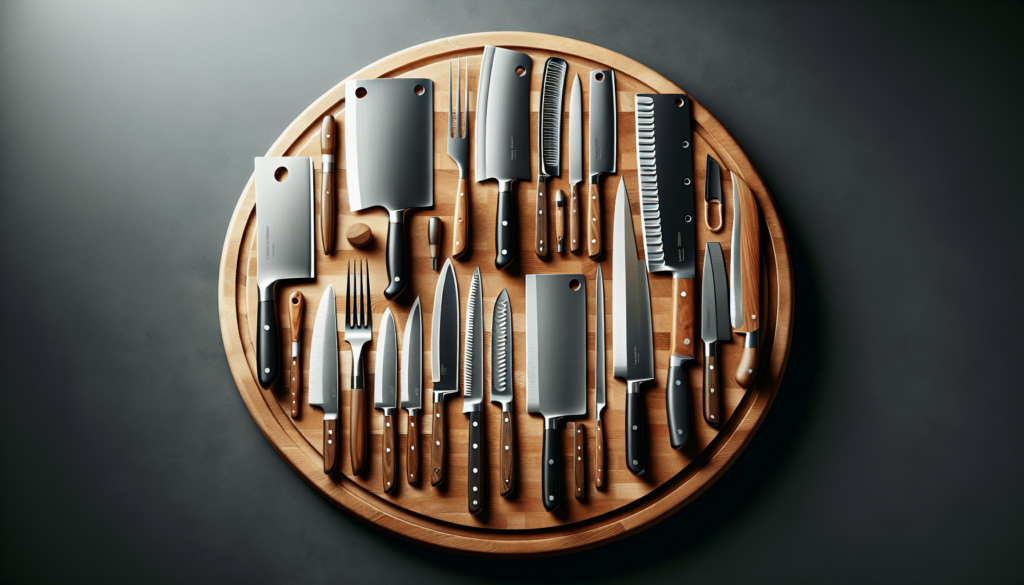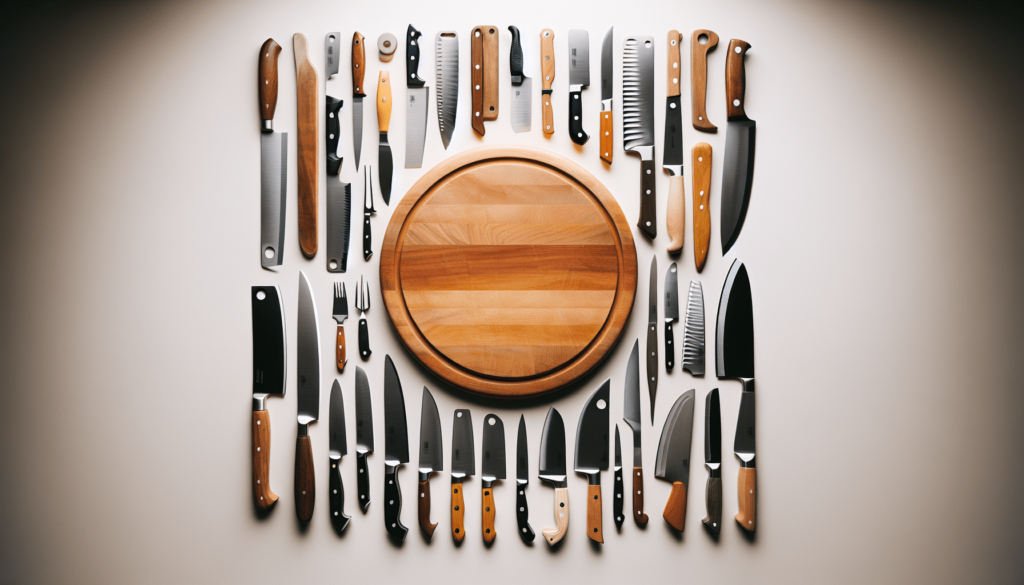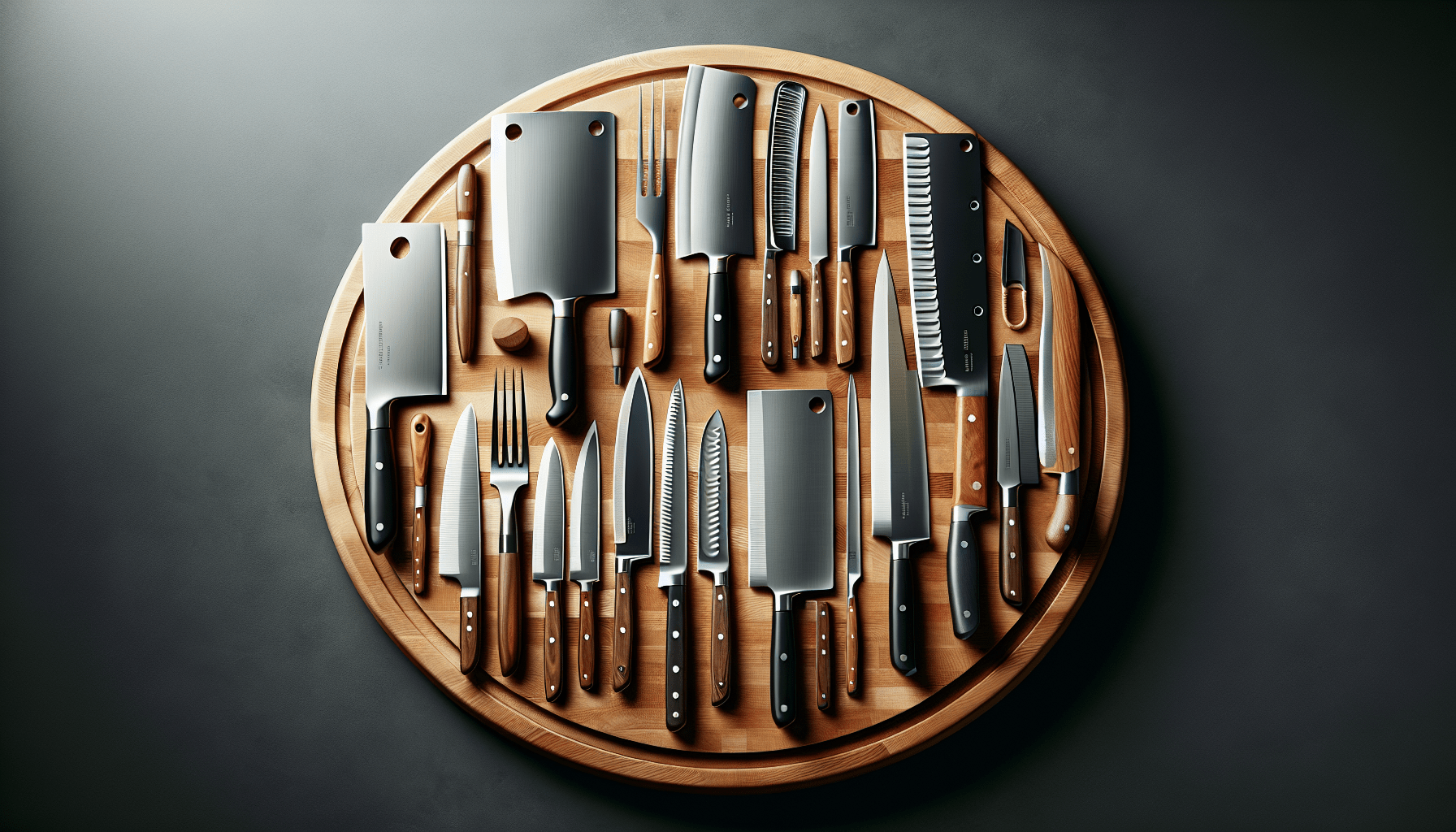In the world of professional cooking, the right tools can make all the difference. And when it comes to the essential tools of a chef, knives take center stage. The main knives for a chef are like a finely tuned orchestra, each one performing a specific role to create culinary masterpieces. With blades designed for precision, efficiency, and versatility, these knives are the unsung heroes that allow chefs to navigate the kitchen with ease and finesse. From the trusty chef’s knife to the nimble paring knife, each one plays a crucial role in the art of culinary craftsmanship. So, let’s dive into the world of knives and discover the main ones that every chef needs in their arsenal.
Chef’s Knife
Overview
The Chef’s Knife, also known as a cook’s knife, is an essential tool for any chef or home cook. It is the workhorse of the kitchen, designed to handle a wide range of cutting tasks. With its versatile blade and ergonomic handle, the Chef’s Knife allows you to chop, slice, and dice ingredients with ease.
Design
The Chef’s Knife typically has a broad, curved blade that tapers to a sharp point. This design allows for a rocking motion when cutting, which increases efficiency and reduces fatigue. The blade is typically between 6 and 12 inches long, with the most common size being 8 inches. The handle is usually made of wood, plastic, or stainless steel, and is designed for a comfortable grip.
Uses
The Chef’s Knife can be used for a variety of tasks in the kitchen. Its primary function is for chopping vegetables, herbs, and fruits, but it is also excellent for slicing proteins like meat and fish. The curved blade facilitates the slicing motion, allowing for thin, even cuts. Additionally, the Chef’s Knife can be used for mincing garlic, crushing spices, and even disjointing large cuts of meat.
Care and Maintenance
To ensure the longevity of your Chef’s Knife, proper care and maintenance are essential. After each use, hand wash the knife with warm, soapy water and dry it immediately. Avoid using abrasive cleaning materials that can damage the blade. Regular sharpening is also crucial to maintain the knife’s performance. Use a sharpening stone or a honing rod to keep the blade edge sharp. Store the Chef’s Knife in a knife block or on a magnetic strip to protect the blade and prevent accidents.
Paring Knife
Overview
The Paring Knife is a small, versatile knife that is perfect for intricate tasks in the kitchen. Its compact size and precise blade make it an indispensable tool for peeling, trimming, and shaping fruits and vegetables.
Design
The Paring Knife typically has a short blade, usually around 3 to 4 inches long. The blade is narrow and pointed, allowing for precise control when working with small ingredients. The handle can be made of various materials and is designed to provide a comfortable grip.
Uses
The Paring Knife is primarily used for tasks that require delicate precision. It excels at peeling fruits and vegetables, removing seeds and cores, and creating garnishes. The narrow blade allows for intricate cuts, such as scoring meat or deveining shrimp. It is also handy for tasks like segmenting citrus fruits and hulling strawberries.
Care and Maintenance
To keep your Paring Knife in optimal condition, it is important to handle it with care. Hand wash it after each use, making sure to remove any food residue. Dry it immediately to prevent any moisture buildup. Regularly sharpen the blade to maintain its sharpness, and store it in a safe place to protect the blade and prevent accidents.

Bread Knife
Overview
The Bread Knife is a must-have tool for any bread lover. With its serrated blade, the Bread Knife effortlessly cuts through crusty bread without crushing or tearing it.
Design
The Bread Knife features a long, serrated blade, usually between 8 and 10 inches long. The serrations enable the knife to grip the crust of the bread while cutting through it, providing clean and precise slices. The handle is often designed with a comfortable grip, allowing for easy maneuverability.
Uses
As the name suggests, the Bread Knife is primarily used for slicing bread. Its serrated blade makes it perfect for crusty or soft bread, ensuring clean slices without compressing the loaf. The Bread Knife is also handy for cutting pastries, cakes, and even slicing through delicate tomatoes or melons.
Care and Maintenance
Proper care and maintenance are crucial to keep your Bread Knife in excellent condition. After each use, hand wash the knife with warm, soapy water, taking care to remove any bread crumbs. Dry it thoroughly to prevent any moisture from affecting the blade. Regularly sharpen the serrated edge using a sharpening stone or a specialized serrated knife sharpener. Store the Bread Knife in a dry and safe place to maintain its durability.
Santoku Knife
Overview
The Santoku Knife is a versatile and popular knife that originated in Japan. With its unique design and functionality, the Santoku Knife has gained popularity worldwide for its ability to handle a wide range of cutting tasks.
Design
The Santoku Knife features a wide, flat blade that is usually between 5 and 7 inches long. The blade has a granton edge, which consists of oval-shaped indentations along the blade’s length. These indentations reduce friction and allow for thin slices to fall away easily. The handle is typically Japanese-style, long and slim, designed for a comfortable grip.
Uses
The Santoku Knife is commonly used for slicing, dicing, and mincing ingredients. Its wide, flat blade provides excellent surface contact and stability, making it ideal for cutting through vegetables, meat, and fish. The granton edge helps prevent food from sticking to the blade, ensuring smoother and cleaner cuts. The Santoku Knife is also suitable for finely chopping herbs and garlic.
Care and Maintenance
To maintain the performance and longevity of your Santoku Knife, proper care is essential. After each use, hand wash the knife with warm, soapy water, ensuring to remove any food particles. Dry the knife thoroughly to prevent any moisture buildup. Regularly sharpen the blade using a sharpening stone or a honing rod. Store the Santoku Knife in a knife block or on a magnetic strip to protect the blade and prevent accidents.

Utility Knife
Overview
The Utility Knife is a versatile and practical knife that serves various purposes in the kitchen. Its smaller size and sharp blade make it a useful tool for everyday food preparation tasks.
Design
The Utility Knife typically features a medium-sized blade, usually between 4 and 6 inches long. The blade is narrower and thinner than a Chef’s Knife but wider than a Paring Knife. The handle is designed to provide a comfortable grip, allowing for easy maneuverability.
Uses
The Utility Knife can handle a wide variety of tasks in the kitchen. Its sharp blade is perfect for slicing, dicing, and chopping small to medium-sized ingredients, such as fruits, vegetables, and cheese. The length and versatility of the Utility Knife make it an excellent choice for trim work, such as removing fat or sinew from meat.
Care and Maintenance
To keep your Utility Knife in optimal condition, proper care and maintenance are necessary. Hand wash the knife with warm, soapy water after each use, making sure to remove any food residue. Dry it thoroughly to prevent any moisture from affecting the blade. Regularly sharpen the blade to maintain its sharpness, and store the Utility Knife in a safe place to protect the blade and prevent accidents.
Boning Knife
Overview
The Boning Knife is a specialized knife that is designed for removing bones and skin from meat, poultry, and fish. With its narrow, flexible blade, the Boning Knife allows for precise and effortless deboning.
Design
The Boning Knife typically has a narrow, sharp blade that is usually between 5 and 7 inches long. The blade is thin and flexible, allowing it to maneuver around bones and joints easily. The handle is designed to provide a comfortable grip and optimal control during delicate tasks.
Uses
The primary use of the Boning Knife is for removing bones from meat, poultry, and fish. Its narrow blade can easily slide between the flesh and bones, allowing for clean and efficient removal. The flexibility of the blade enables it to work around joints and contours, ensuring minimal waste. The Boning Knife is also excellent for skinning fish or removing silver skin from meat.
Care and Maintenance
Proper care and maintenance are crucial to keep your Boning Knife in excellent condition. After each use, hand wash the knife with warm, soapy water, making sure to remove any meat or fish residue. Dry it thoroughly to prevent any moisture buildup. Regularly sharpen the blade to maintain its sharpness, and store the Boning Knife in a safe place away from other knives to protect the blade and prevent accidents.
Carving Knife
Overview
The Carving Knife is a long, slender knife that is specifically designed for carving and slicing large cuts of meat. With its sharp, narrow blade, the Carving Knife allows for precise and uniform slices, making it perfect for roasts, hams, and turkeys.
Design
The Carving Knife typically has a long, narrow blade that is usually between 8 and 14 inches long. The blade is sharp and pointed, allowing for smooth, even cuts. The handle is designed to provide a comfortable and secure grip during carving tasks.
Uses
As the name suggests, the Carving Knife is primarily used for carving cooked meats. Its long, thin blade effortlessly cuts through large roasts or poultry, ensuring uniform slices. The sharp point allows for precise control when maneuvering around bones and joints. The Carving Knife can also be used for slicing other large foods such as melons or cakes.
Care and Maintenance
Proper care and maintenance are essential to keep your Carving Knife in excellent condition. After each use, hand wash the knife with warm, soapy water, ensuring to remove any meat or food particles. Dry it thoroughly to prevent any moisture from affecting the blade. Regularly sharpen the blade to maintain its sharpness, and store the Carving Knife in a sheath or protective cover to protect the blade and prevent accidents.
Cleaver
Overview
The Cleaver is a heavy-duty knife that is commonly used in butchering and chopping tasks. With its thick, sturdy blade, the Cleaver can handle tough cuts of meat and dense ingredients with ease.
Design
The Cleaver typically has a large, rectangular blade that is thick and heavy. The blade is usually between 6 and 12 inches long and has a flat edge. The handle is designed to provide stability and control, with a comfortable grip for heavy chopping tasks.
Uses
The primary use of the Cleaver is for butchering tasks, such as cutting through bones, cartilage, and tough connective tissue. Its heavy blade and sturdy construction allow for powerful and precise cuts. Additionally, the Cleaver can be used for chopping through dense ingredients like squash or melons, as well as crushing garlic or ginger.
Care and Maintenance
To maintain the performance and longevity of your Cleaver, proper care is essential. After each use, hand wash the knife with warm, soapy water, making sure to remove any food residue. Dry it thoroughly to prevent any moisture buildup. Regularly sharpen the blade to maintain its sharpness, and store the Cleaver in a safe place to protect the blade and prevent accidents.
Filleting Knife
Overview
The Filleting Knife is a specialized knife that is designed for precision filleting and deboning of fish. With its thin, flexible blade, the Filleting Knife allows for precise control and maneuverability when working with delicate seafood.
Design
The Filleting Knife typically has a thin, flexible blade that is usually between 6 and 9 inches long. The blade is sharp and pointed, allowing for precise cuts and maneuvering around the bones of fish. The handle is designed to provide a comfortable grip and optimal control during filleting tasks.
Uses
The primary use of the Filleting Knife is for filleting and deboning fish. Its thin, flexible blade easily glides along the contours of the fish, separating the flesh from the bones. The sharp point allows for precise cuts, ensuring minimal waste. The Filleting Knife can also be used for delicate tasks like removing silver skin from meat or trimming fat.
Care and Maintenance
Proper care and maintenance are crucial to keep your Filleting Knife in excellent condition. After each use, hand wash the knife with warm, soapy water, making sure to remove any fish or seafood residue. Dry it thoroughly to prevent any moisture buildup. Regularly sharpen the blade to maintain its sharpness, and store the Filleting Knife in a sheath or protective cover to protect the blade and prevent accidents.
Serrated Knife
Overview
The Serrated Knife, also known as a bread knife or tomato knife, is characterized by its serrated edge, making it perfect for slicing foods with tough exteriors and soft interiors. With its unique design, the Serrated Knife ensures clean and effortless cutting without crushing delicate ingredients.
Design
The Serrated Knife features a long blade with serrations along one edge. The length of the blade can vary, but it is typically between 8 and 10 inches long. The serrated edge allows for easy cutting through foods with tough exteriors, such as bread or tomatoes, without tearing or crushing the delicate interiors. The handle is designed for a comfortable grip during slicing tasks.
Uses
The primary use of the Serrated Knife is for slicing through foods with tough exteriors and soft interiors. It excels at cutting through crusty bread, bagels, and cakes, delivering clean slices without compressing the delicate interior. The serrations grip the surface of tomatoes and other soft fruits, enabling precise cuts without squishing the fruit. The Serrated Knife can also be used for slicing through citrus fruits, pineapples, melons, and other foods with tough or slippery exteriors.
Care and Maintenance
To keep your Serrated Knife in optimal condition, proper care and maintenance are necessary. Hand wash the knife with warm, soapy water after each use to remove any food residue, taking care to clean between the serrations. Dry it immediately to prevent any moisture buildup. Regularly sharpen the serrated edge using a specialized serrated knife sharpener or a sharpening stone. Store the Serrated Knife in a dry and safe place to maintain its durability and prevent accidents.
In conclusion, every chef or home cook should have a set of essential knives in their kitchen. The Chef’s Knife, Paring Knife, Bread Knife, Santoku Knife, Utility Knife, Boning Knife, Carving Knife, Cleaver, Filleting Knife, and Serrated Knife each serve a unique purpose and are designed to handle specific tasks. By understanding the design, uses, and proper care and maintenance of each knife, you can enhance your culinary skills and make cooking a more enjoyable experience. Whether you’re slicing, dicing, or deboning, having the right knife for the job will make a world of difference in your kitchen. So, invest in quality knives and enjoy the art of cooking with precision and efficiency. Happy cooking!
